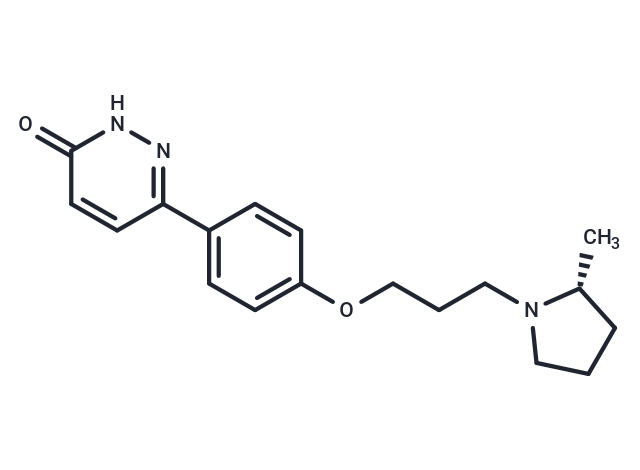Shopping Cart
- Remove All
 Your shopping cart is currently empty
Your shopping cart is currently empty

Irdabisant (CEP-26401) (CEP-26401) is a selective, orally active and blood-brain barrier (BBB) penetrant antagonist/inverse agonist of histamine H3 receptor (H3R) (rat H3R Ki= 7.2 nM, human H3R Ki= 2.0 nM). Irdabisant exhibits relatively low inhibitory activity against hERG current (IC50= 13.8 μM). Irdabisant exhibits cognition-enhancing and wake-promoting activities in the rat social recognition model. Irdabisant can be used for research on schizophrenia or cognitive impairment.

| Pack Size | Price | Availability | Quantity |
|---|---|---|---|
| 1 mg | 50 € | In Stock | |
| 5 mg | 129 € | In Stock | |
| 10 mg | 188 € | In Stock | |
| 25 mg | 335 € | In Stock | |
| 50 mg | 470 € | In Stock | |
| 100 mg | 661 € | In Stock | |
| 500 mg | 1.320 € | In Stock | |
| 1 mL x 10 mM (in DMSO) | 89 € | In Stock |
| Description | Irdabisant (CEP-26401) (CEP-26401) is a selective, orally active and blood-brain barrier (BBB) penetrant antagonist/inverse agonist of histamine H3 receptor (H3R) (rat H3R Ki= 7.2 nM, human H3R Ki= 2.0 nM). Irdabisant exhibits relatively low inhibitory activity against hERG current (IC50= 13.8 μM). Irdabisant exhibits cognition-enhancing and wake-promoting activities in the rat social recognition model. Irdabisant can be used for research on schizophrenia or cognitive impairment. |
| Targets&IC50 | H3 receptor (rat):7.2 nM (Ki), H3 receptor (human):2 nM (Ki) |
| In vitro | Irdabisant exhibits inverse agonist activity with EC50 values of 2.0 nM and 1.1 nM for rat H3R and human H3R, respectively; exhibits antagonist activity with Kb, app values of 1.0 nM and 0.4 nM for rat H3R and human H3R, respectively. Irdabisant exhibits moderate activity at Muscarinic M2 (Ki = 3.7 ± 0.0 μM) and Adrenergic α1A (Ki = 9.8 ± 0.3 μM) receptors, Norepinephrine transporters (Ki = 10 ± 1 μM), Dopamine transporters (Ki = 11 ± 2 μM), and phosphodiesterase PDE3 (IC50 = 15 ± 1 μM). Irdabisant inhibits the cytochrome P450 enzymes CYP1A2, 2C9, 2C19, 2D6, and 3A4 with IC50 values of greater than 30 μM, indicating less potential for drug-drug interactions[1]. |
| In vivo | Irdabisant (0.0001-0.1 mg/kg; i.v. or p.o.; single dosage) improves performance in the rat social recognition model of short-term memory. Irdabisant (0.01-0.3 mg/kg; p.o.; single dosage) dose-dependently inhibits H3R agonist RAMH-induced dipsogenia. Irdabisant (1 mg/kg for i.v. and 3 mg/kg for p.o.; single dosage) is rapidly absorbed with high oral bioavailability in rat and monkey, and exhibits a moderate clearance in monkey and dog compared to the rat[1]. Irdabisant (3-30 mg/kg; p.o.; single dosage) exhibits wake-promoting activity in rat. Irdabisant (3-30 mg/kg; i.p.) increases prepulse inhibition (PPI) in DBA/2NCrl mice[2]. |
| Alias | CEP-26401, CEP26401, CEP 26401 |
| Molecular Weight | 313.39 |
| Formula | C18H23N3O2 |
| Cas No. | 1005402-19-6 |
| Smiles | O(CCCN1[C@H](C)CCC1)C2=CC=C(C=C2)C=3C=CC(=O)NN3 |
| Relative Density. | 1.20 g/cm3 (Predicted) |
| Storage | Powder: -20°C for 3 years | In solvent: -80°C for 1 year | Shipping with blue ice. | ||||||||||||||||||||||||||||||
| Solubility Information | DMSO: 22.5 mg/mL (71.79 mM) | ||||||||||||||||||||||||||||||
Solution Preparation Table | |||||||||||||||||||||||||||||||
DMSO
| |||||||||||||||||||||||||||||||

Copyright © 2015-2024 TargetMol Chemicals Inc. All Rights Reserved.